In today’s market, buyers expect haulers to step up their online sales game. The big national companies have “buy now” functionality on their websites. Haulers of every size should as well.
By K. Ryan Hasse
Often referred to as The Amazon Effect, 80 percent of shoppers expect to be able to buy products and services online. 24/7/365. Right now. (-Forbes)
Because of this, the fact that so many people want to and do shop online, Jeff Bezos is now, by far, the richest man in the world (worth $40b more than second place, Bill Gates!). By creating an easy online “buy now” experience, Amazon has shifted how people buy, and how people expect to buy. This big tell is how business to consumer service companies must sell or lose ground.
But Amazon is primarily about products; housewares, gifts, electronics, etc. What about services, such as waste removal? The buyer expectations are already set; they want to buy services online as well. Note the myriad of service related websites attempting to meet that demand. Unfortunately, most of those are of the “fill out a form and wait for a response” variety or worse: “Fill out a form and be called back by a pesky sales rep.” Not good. That is not “buy now.” That is a circa 2000 way of thinking. To many, it is just annoying. Thus, none of those website creators threaten to unseat Mr. Bezos from his #1 perch anytime soon.
Amazon has proven the “buy now” model and created vast marketplace expectations. Therefore, haulers must meet the buyer on their preferred terms; they must offer “buy now” functionality on their website. Those who do not will lose business to those who do.
So how can “buy now” functionality be implemented in the waste services marketplace? It is not easy, which is why so few are doing it. Below is a discussion of why a “buy now” button on a hauler’s website is actually quite complex and expensive for a hauler to develop, deploy and support, and yet is an absolute necessity in today’s market.
What Does the “Buy Now” Functionality on a Hauler’s Website Do?
When this article refers to “buy now” functionality, it means the ability for a customer to view a quote, sign/agree to service terms, and pay for those services via the hauler’s own website. This is not “fill out a form and we will get back to you” or “you can pay your bill online” functionality. “Buy now” is for new customers who arrive at the hauler’s website to buy services for the first time, or existing customers to add/remove services. In order to do so, the “buy now” process must identify where a customer lives through a process known as “geolocation.”
Geolocation: Where Does the Customer Live and Are They Serviceable?
Every hauler identifies their service areas (often organized by “route”). Therefore, customers seeking service from a hauler must first be geolocated to determine whether or not they live in an area that is serviceable. After the customer enters their (service) address, the geolocation/mapping software must precisely determine in which route, if any, the service address is located. Service area mapping must be precise, often identifying specific borders (like city boundaries, county lines, neighborhoods, associations, etc.). Map “polygons” are designed to be precise representations of where a hauler wants to sell (sales polygons), as differentiated from where a hauler currently services (operational polygons) (see Figure 1).
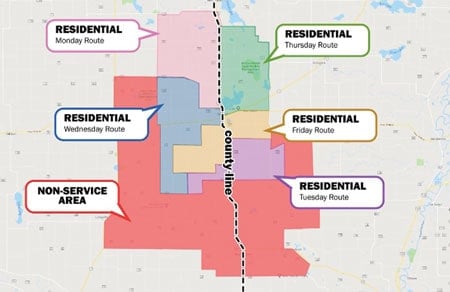
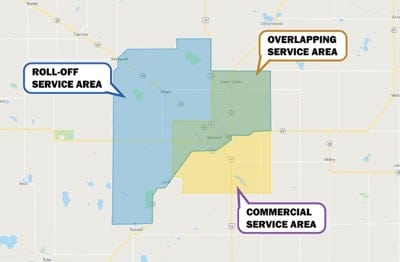
Because many haulers offer multiple service types, the mapping software must also be able to “layer” one service polygon upon another (see Figure 2). As a result, mapping software gets very complex and expensive to develop, implement and maintain.
View a Quote: What Services are Available at What Price?
If the customer’s address geolocates within a serviceable area, in order for a sale to be made, the quoting software must show the customer which services are available and at what price. Due to potential differences in local taxes/fees or distance/delivery charges, etc., pricing for services often needs to be specific to a customer’s precise service location. In order to deliver an accurate quote, the quoting software must have infinite flexibility to accommodate not only multiple locations, but also multiple service/product types (residential service, recycling, yard waste, roll-offs, etc.). It must also be easy to update and maintain.
Some haulers charge fuel surcharges, local fees, distance charges or other charges based on location. Thus, the software must know where the customer lives in order to generate an accurate price.
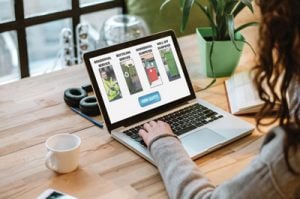
As an aside, some old-school haulers baulk at the idea of listing their prices online. That is a 1950s way of thinking, and not in tune with today’s buyers. Nor is it consistent with how the biggest companies got and stay … big. Successful companies know that customers want to view a quote, sign for service and pay. Waste services are not somehow isolated or granted exception by the marketplace. They are like any other service.
Yes, there are price sensitive buyers. However, many more buyers seek product/service differentiation. Do you offer recycling? Weekly or every other week? Do you offer yard waste? Concierge/walk up service (great in snow belt, or for elderly customers)? Cart washing/periodic exchange? What about “on demand” pick up service? Broadcast text reminders for service interruptions, holiday schedules or biweekly recycling pick up reminders? There are many ways a hauler can distinguish themselves. Protectionism, hiding from competition or high-pressure sales tactics are firmly rejected by the online market.
Concerned about price being the main criteria for a buyer? Simple: offer a competition price match guarantee. Most customers will buy happily because you made buying easy. Few will bother to chase those couple bucks by power shopping. If they do, collect the competitive information in your CRM (see Figure 3).
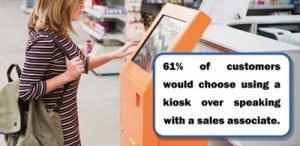
Making the Sale: A Frictionless Online Buying Experience
Customers expect an easy experience when making an online purchase. Customers want to see their options, select from their choices and if they like the quote, commit to the purchase/agreement, pay and move on with their life.
The ease with which a customer makes an online purchase has become not only the preferred purchase method for the majority, but also a mark of quality. Customers view your organization’s online storefront as a leading indicator of the overall quality of the organization itself (Forbes).
Do you read each airline and hotel’s company story before you book with them online? Likely not. Your customers do not really care to read that stuff either. The quality of your website and the ease with which to purchase implies quality. That is what they want—an easy way to view a quote, sign, pay and be done (see Figure 4).
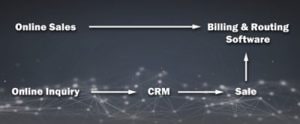
Sales Data/Systems Integration: Sending Data to People and Software
Once an online sale is made, information needs to be sent to the requisite people and/or software systems. Sales data consists of contact/billing info, product/service types and financial transaction information. This information can be integrated to a hauler’s billing, operations and/or routing software products. Work order data can be sent directly to the individual(s) responsible for delivering carts/bins/dumpsters. Leveraging e-mail, text and other forms of instant notification can speed up the data transfer from sales to operations.
CRM: Maximize Every Lead with Fast Response Times
The other form of sales data are the leads generated from non-sales—those buyers who may have viewed a quote, but for whatever reason, did not purchase. As a best practice, leads should be sent to a CRM (Customer Relationship Management) system for immediate follow up. Those leads amass to become part of larger marketing campaigns.
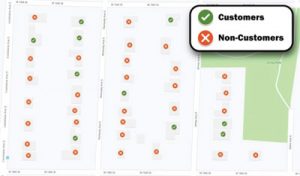
In today’s world, speed of response matters, a lot. Customers are uninterested in “leave a message/fill out an online form, and we’ll get back to you” approach. That is 1970 to 2000 levels of customer service and sales. So, a CRM designed to trigger a fast response for leads is critical. Plus, in the waste industry, leads age out as buyers find your competition. If your competition has “buy now” functionality, and you do not, you will likely lose that business. So, a CRM by itself is not the whole answer.
Mapping lead activity helps determine whether or not to expand service areas into new areas, or perhaps where your company has a competitive advantage. When a big national company buys out a local hauler, be prepared! Launch your marketing campaign to those addresses to pick up as much of that new business as possible (see Figure 5).
Focused Marketing: Target Your Customer and Sell
Once sales polygons are created, a proper sales system will provide all the addresses in those polygons. Doing this in conjunction with a CRM will allow the creation of targeted marketing campaigns (see Figure 6). Marketing by zip codes, or third-party mail inserts to imprecise zones is not only inefficient and expensive, it is also clumsy and unprofessional. Why mail an insert to a person you cannot service, or worse—to an existing customer—only to look bad, and waste both their time and your employee’s time in a conversation that cannot possibly lead to a sale (sending introductory/new customer pricing to existing customers is a sure way to make them angry).
Target marketing applies to customers as well. Existing in-route customers can benefit from such campaigns. For example, a campaign that texts a link offering a service they do not currently have can be very effective. “Fall cleanup time! Click here to add yard waste service to your account.” That “click here” is a texted link to “buy now” functionality, making it easy to upsell.
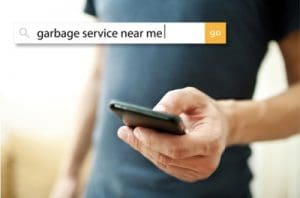
SEO: Driving Online Customers to the “Buy Now” Button
Once the online sales system is set up, next comes driving customers to the “buy now” button. What customers? Those who land in the sales polygons. How? There are many ways, starting with traditional SEO (Search Engine Optimization). Customers often search for services using online search phrases such as “garbage service near me” or “waste service <city><state>.” The big national haulers know this and have optimized their websites (with “buy now” functionality) to capture this easy lay-down business. Smaller haulers, most of which cannot afford the technology as outlined herein, are ceding this easy self-service business to the big nationals.
Mobile Sales: 77 Percent of Americans Own a Smartphone and They Use it to Purchase
An online sales system must be mobile, useable by the customer him/herself, outside sales staff, and third-party sellers. Buyers expect to be able to use their phones to complete a purchase. This may be as straightforward as the customer using the hauler’s mobile enabled online sales system to complete a purchase (a lot goes on to make that happen). Or, it may also include the ability for the sales system to text a “buy now” link to a potential customer when the customer hovers their phone over a QR code. QR codes or text numbers, can be placed on carts/bins/dumpsters, refrigerator magnets (realtor affiliations), traditional paper media (bulk ads, mailers) or anywhere else imaginable. Bottom line: make it easy for customers to buy using their mobile device (see Figure 7).
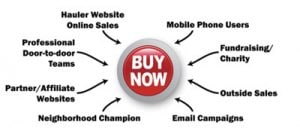
Outside sales must also be able to use the sales system. Professional door knockers, cold callers or even the neighborhood homeowner who is incentivized to sign up his/her neighbors—all of these people can use a mobile sales system. This brings your ability to sign up customers (and complete a credit card transaction) to any event, fundraiser, charity, county fair or wherever else selling can happen. This capability, in conjunction with Promo Code tracking (the ability to track the sales channel), allows a hauler to create an army of sales reps (see Figure 8).
Regulatory Compliance: Keeping Ahead of Privacy and Credit Card Regulations
The rules for collecting, storing and using customer data (“privacy laws”) are becoming more and more stringent with each passing year. Credit card/transactional security has become even more strict. Moreover, insurers are increasing business insurance rates based on PCI (Payment Card Industry) compliance. Fines for breaches/non-compliance can easily reach into the tens of thousands of dollars. The prevalent practice of a human being collecting a credit card number over the phone is on trajectory to become illegal.
What will haulers do?
A sales software that offers multiple compliant ways of completing a transaction is a first start. Online transactions are easy to control relative to transactions involving a human being (call center, customer service rep, etc.). Since customers prefer this method of purchasing, a hauler that uses an online “buy now” button is not inconveniencing their customers—they are making it easier (and safer) for their customers to buy.
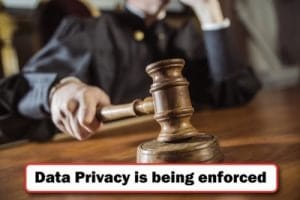
For those (minority of) customers who still prefer to call, linking the customer service rep (human being) to a phone-based IVR-type system to collect credit card/payment information is a solid second choice. Customers are also used to this (“Ok miss, I will now transfer you to our secure payment system …”). A system that e-mails the customer a link to an online agreement (and subsequent credit card portal) is also a compliance option. Whether online or IVR, syncing all of the secure/tokenized transaction data to the hauler’s billing and operations systems becomes absolutely necessary to remain compliant (see Figure 9).
Cost of Sale: Customer Self-Service Lowers a Hauler’s Cost of Sale
Expedia and Priceline have 95 percent market share! If this does not convince you of how people shop, nothing will. Because of this efficiency, the “real dollars” (adjusted for inflation) cost of travel has decreased markedly, leading to an overall cost of sale decrease for the industry (far fewer travel agent commissions).
Furthermore, a significant portion of travel bookings occurs after hours, during holidays, or during times when a traditional human being is not available to answer a phone. The waste services industry is not isolated from these market forces (rather, they are either ignoring them, or unable to meet the need due to the expense of an online sales system). The big nationals know this. They have their online sales systems already deployed. They SEO their websites. They dominate online sales. Each of these online sales requires no human intervention, so they are in the process of lowering their cost of sale, furthering their marketplace advantage (see Figure 10).
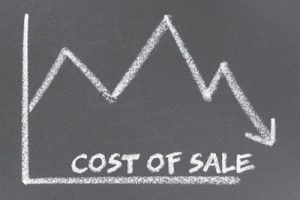
Haulers Must Service Online buyers with “Buy now” Functionality
Given the myriad of complexities and technical know-how outlined above, how can a hauler afford to develop, implement, and support an online sales system? We have it on good authority that the big national companies have spent many millions each to bring “buy now” functionality to online buyers (one report was $40m and climbing). This is simply out of reach for most haulers. Yet marketplace and regulatory conditions make such a system an absolute necessity.
Because most haulers do not have the resources to natively develop, deploy and support such a system, there are new software solutions available that address the issues above. Look for an affordable online sales system that deploys on a haulers existing website and is mobile, scalable, secure. These companies can create the mapping, design the online quotes/agreements, integrate to your software systems, deploy on your website and result in regulatory compliance.
In today’s market, with Amazon only gaining ground in the marketplace, buyers expect haulers to step up their online sales game. The big national companies have “buy now” functionality on their websites. Haulers of every size should as well. | WA
K. Ryan Hasse is CEO of SalesStryke Software, creators of the TrashBolt Software Sales System (Plymouth, MN) for haulers, by haulers. Hasse was part of the GarbageMan, Inc. team, a Minnesota-based hauler. Garbageman was sold to Waste Management in 2018 after amassing more than 110,000 customers in just nine years. He now leads hauler clients to their growth objectives. TrashBolt Software has made its mark in the waste services industry by offering affordable, rapid deployment “buy now” functionality for haulers to deploy on their websites. For more information, visit www.trashbolt.com.
You may also like:
7 Recent Content Marketing Trends to Use for Your Waste Business
